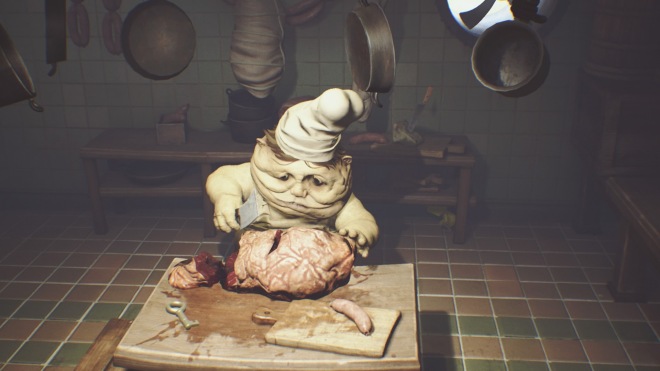Games, where bad things happen to small children, is a strangely popular theme, with Playdead’s Limbo and Inside being the first to spring to mind. Joining them, we have Little Nightmares, a game that puts you in the tiny shoes of Six, a small girl whose most distinguishing feature is a bright yellow raincoat. It’s up to you to help her escape the Maw, a mysterious underwater building with extremely questionable morals.
If you’ve played either of Playdead’s classics, the mechanics will be familiar. You’ll have fairly simple controls and set to work solving puzzles by pushing, pulling and interacting with stuff. Narratively, it also tells an intriguing story visually rather than with words.
The environment is littered with details that reveal information about the Maw, and what befalls the trapped children found there. It’s also a story about survival and, more specifically, what Six will sacrifice to make sure she does. Seeing precisely what she will lose to escape is upsetting but undeniably compelling. It’s a different kind of horror to the type we’re familiar with.
It doesn’t go for the jump scare approach your Outlast’s and Five Nights at Freddy’s favour. In fact, it barely has one to its name. Instead, it aims to unsettle and disturb rather than make you leap out of your chair. It wants its horrors to linger in the back of your mind, not be forgotten after the umpteenth time a monster has appeared out of nowhere and screamed rudely in your face.
In a lot of ways, it does manage this. The wonderfully hideous designs of the enemies aren’t going to live fondly in the memory. Firstly, you come across a short blind chap with incredibly long arms. Sounds pretty amusing, right? Wait until he pulls himself out of vents and uses his keen sense of smell to track you down. Then he becomes horrifying.
The overweight chefs also instil a similar feeling. It’s not just their grotesque melted looking faces. The horrible sound they make when they spot you sneaking about in their kitchens is disturbing. They unleash an inhuman wail and chase you down before scooping you up like a child unfamiliar with proper pet handling technique. Then, they’ll stuff you inside of a fish head as an extra flavouring for the meal they’re preparing.
The scale of the world also plays a big part in giving Little Nightmares its creepy edge. Six is incredibly tiny. During your four-hour stint in the Maw, you will find several everyday objects like shoes and books that remind you just how small she is. Even keys need to be hauled around as though you’re moving a bag of cement. It makes everything seem intimidating.
To the player, this is just platforming, but to Six, she’s just trying to get around a world that enemies navigate with no issue. This means being unable to climb over a simple box is the difference between life and being cooked in a fish head. It does an excellent job of making you feel helpless and naturally makes you want to hide away from the games’ dangers.

And that’s pretty much what you’ll be doing. Little Nightmares is essentially a high-stakes game of Hide and Seek, with some other puzzles thrown in too. You will find yourself figuring out different ways to open doors and ducking under tables or inside boxes to avoid the gaze of enemies.
These light stealth sections excel at creating tension as you pray long-armed man won’t get his spindly fingers on you. But, the puzzles are rarely interesting enough to be memorable. They’re mostly just different variants of opening a door, far from awful, but you won’t find yourself revelling in that ‘aha’ moment you get when solving a satisfying conundrum.
Thematically though, they are excellent. One puzzle requires you to gather chunks of meat to make a sausage rope to swing from. Once you discover the meat’s origin, it suddenly becomes a lot more sinister and infinitely less cutesy. You’ll also find yourself pushing cages with children trapped in them so you can reach higher places. There’s no option to save them. You have to accept they’re part of how you move on.
Beyond this, you’ll embark on a few platforming jaunts. Most notably in the fourth chapter which is predominantly a chase sequence. This section highlights a few niggles with the controls. Six isn’t the most elegant or agile character to play. She feels very slow to respond to inputs, which leads to a lot of unnecessary deaths.
This is only exacerbated by having 3D movement in a 2D perspective. You’ll start a jump assuming you can reach that metal box, only to find yourself plummeting into the abyss. This isn’t a consistent problem, but it can make doing a lengthy platforming section again a little irksome.
On top of this, landing these jumps isn’t smooth either. The game will often teleport you a small, barely noticeable distance to your destination. This is most obvious when leaping to a door handle. Sometimes you can tell you’re not going to make it before the game decides it’s close enough and simply teleports you that extra distance. It’s not a huge deal-breaker, but it makes everything feel a tad unpolished.
Little Nightmare’s story is an interesting and often unsettling one, and it’s a fantastic looking game if you’re into macabre stuff. But the platforming can occasionally be frustrating, and the puzzles leave a lot to be desired. Little Nightmares is definitely worth your time, but the gameplay pales compared to the atmosphere the game successfully creates, which is a shame.
6/10
